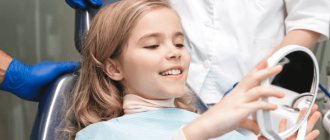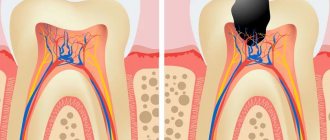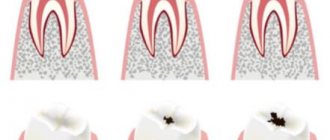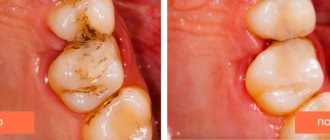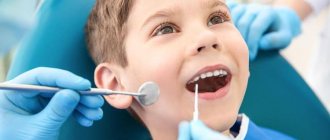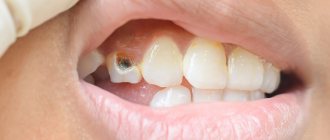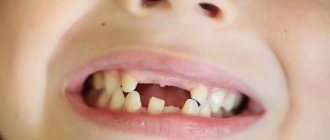1291
Long gone is the era when caries treatment was an unpleasant and painful procedure. In modern cliques you rarely hear a drill that horrifies all its patients.
Today, minimally invasive techniques have begun to be used that involve getting rid of the disease without drilling teeth. One of them is ozone therapy.
general information
This is a non-contact method of treating cavities affected by caries. The essence of the technology is the disinfection of carious tissues with ozone due to the destruction of pathogenic microflora on surfaces.
Ozone is an unstable, highly active chemical compound with good penetrating ability, consisting of three oxygen molecules. It has a pronounced bactericidal effect, destroying up to 98% of pathogenic bacteria located in the carious cavity.
The compound, destroying the cell membrane of fungi, bacteria and viruses, leads to the death of the cells themselves. Being at the same time an oxidizing agent, ozone easily enters the affected tissues without affecting healthy ones. Essentially, it sterilizes them, preventing the disease from occurring again.
In addition to the mentioned properties, the compound has antihypoxic, fungicidal, anti-inflammatory, analgesic and immunocorrective effects. The list of properties includes improved blood supply to tissues, oxygen saturation of cells, and improved metabolic processes.
Ozonation is especially effective in the initial form of caries , when there is no need to fill the affected unit. The dentist only needs to perform its remineralization. The procedure can also be used to treat (sterilize) large carious cavities. But then, upon completion, the cavity must be closed with a filling.
The technique was developed and first tested in Frankfurt (Germany) in 2003. A few years earlier (in 1986), ozone therapy was used in the treatment of generalized periodontitis and gingivitis.
How does ozone work?
If periodontal disease is detected in its early stages, ozone removes the infection, improves blood circulation and accelerates healing.
As a prophylactic agent, ozone is used to treat the oral cavity, which removes bacteria and the unpleasant odor they cause. Works wonderfully against inflammatory processes in the oral mucosa.
Those who can compare the treatment of caries using an old, but not always good, drill and a stream of triatomic oxygen are especially grateful to the technique. If using drills it was necessary to drill out the entire damaged surface, and then fill the resulting gap with a cementitious composition. Now a silicone crown is attached to the tooth and ozone is supplied, which destroys microbes. Of course, this method is acceptable if caries has not yet eaten away the enamel before forming a hole. Otherwise, ozone will no longer help. After such a procedure for “ozonizing” caries, you should visit the dentist once every six months to avoid the formation of recurrent caries.
But what to do if caries has already done its rotten work and there is still a hole? In this case, ozone can reduce the specialist’s working time. The sequence of actions will be as follows:
- disinfection;
- removing damaged tissue with a drill;
- filling.
Ozone will act as an analgesic and anesthetic.
If you read an advertisement that completely promises to get rid of caries exclusively with an ozone jet, remember that this is only possible in the first and second stages of caries attack on the tooth.
This is interesting: Gums bleed: what to do at home and how to treat with folk remedies
Equipment used
For ozonation in dentistry, several models of special devices are used - ozonizers, but they all have the same operating principle:
- Air is drawn in using a special pump. It then enters the filter, where moisture and contaminants are removed.
- Dry and clean air is supplied to the generator , where it is converted into ozone.
- The gas is supplied through a hose , at the end of which a silicone tip is attached.
- The vacuum pump creates a pressure below atmospheric. Due to this, the cap is hermetically “sucked” to the tooth being treated.
- Each device is equipped with a sensor that does not allow the ozone concentration and exposure time required for treatment to be exceeded. Thus, with the initial form of caries, a small volume of the drug is sufficient with a procedure duration of 0.5 minutes.
The principle of influencing pathogenic microorganisms is simple. Ozone, after entering a carious cavity, in an artificial vacuum breaks down into atomic and molecular oxygen.
It is attracted to bacteria that are negatively infected and do not have a protective coating of cholesterol, destroying their structure. 30-40 seconds is enough for all microorganisms in the cavity to die.
Tactics of dental canal treatment under a microscope and the advantages of the method.
Let's talk here about the purpose of liquid rubber dam in dentistry.
At this address https://www.vash-dentist.ru/lechenie/zubyi/karies/klassifikatsii-po-mkb-10.html we suggest that you familiarize yourself with the classification of caries according to ICD 10.
How is ozone used in modern dental practice?
Triatomic oxygen, called ozone, has found quite wide application in medicine, in particular in dentistry. The gas has excellent oxidizing properties, which makes it almost a panacea in many branches of medicine. Special techniques and devices were developed, thanks to which dental therapy took several progressive steps. Humanity owes them to the discoveries that were made in Germany.
Ozone therapy techniques involve the introduction of a pressure jet of ozone into the oral cavity and on the surface of the teeth, destroying bacteria, which helps get rid of inflammation. Another positive point: tooth enamel stops decomposing, and this is extremely difficult to achieve by other methods.
All this suggests that surgical intervention in dentistry is gradually being reduced to minimal manipulations and procedures. Ozone is an effective property in the treatment of such dental ailments:
- caries;
- periodontitis;
- phlegmon.
This gas also perfectly disinfects instruments, implants, prostheses, and helps to heal various wound surfaces faster.
In less than half a minute, you are no longer afraid of pathogenic viruses and microbes that encourage the development of caries. Moreover, all manipulations occur absolutely painlessly. Complications are completely excluded.
Indications and contraindications
This technique in dentistry is applicable for the following diseases:
- Superficial caries (i.e. in the chalk spot stage).
- Inflammation in the gums.
- Caries of root canals.
- Fungal infection affecting the enamel.
- Problems related to difficulties in the appearance of teeth.
- Diseases of the mucous membrane.
- Pulpitis and periodontitis.
- Oral wounds of various etiologies and stomatitis.
- Aphthous and herpetic ulcers.
- Bleeding gums.
- Damage caused by prosthetic structures.
- Disinfection of the mouth before implantation.
Ozonation is contraindicated if the patient, at the time of seeking medical help, is diagnosed with:
- Somatic pathology in the active phase.
- Intoxication of the body (alcohol, drugs).
The following conditions are considered absolute contraindications:
- High sensitivity to ozone.
- Neuropsychological disorder.
- Tendency to convulsive state.
- Hypotension.
- Impaired functionality of the thyroid gland.
- Poor blood clotting.
- Thrombocytopenia.
- Circulatory disorders.
In what cases will ozone dental treatment help?
- HealOzone root canal disinfection quickly eliminates bacteria, reducing the risk of recurrence of the disease
- Caries in the spot stage During treatment, we use ozone therapy in conjunction with the DIAGNOdent device. This approach allows you to find all the foci of caries and stop them at an early stage.
- Treatment of diseases of the gums, oral mucosa and lips After the first procedure, you will notice that the condition of your gums has improved, bleeding and inflammation will decrease
During endodontic treatment, it is very important not only to eliminate microbes, but also to carefully restore the anatomy of the tooth. Our dentist-therapist Naira Samvelovna Panosyan completed a course in aesthetic restoration and successfully applies this knowledge in practice. The doctor will precisely restore the shape of your tooth after treatment, and it will look healthy.
The decision to use ozone therapy in our clinic is made only after a thorough examination. You will have your initial appointment with the head physician, Davoyan Artashes Eduardovich. He diagnoses the oral cavity and prescribes further treatment, referring you to our other specialists. Come to one of the Happy Dents clinics, on Leninsky Prospekt or Academician Tupolev Street, for dental treatment using modern techniques.
Advantages and disadvantages of the method
In dentistry, ozone therapy is the most painless, effective and safe non-invasive method. It is ideal for eliminating initial caries, where there is no need for anesthesia, preparation and filling of dental tissues.
The following characteristics are indicated as advantages:
- applicable in pediatric dentistry;
- high sterility due to non-contact;
- does not lead to allergies and is suitable for all patients;
- sterilization of the tooth is complete, which means that re-infection and secondary manifestations of the disease are not allowed;
- the treatment takes place quickly, and there is not even any discomfort;
- no side effects;
- serves as the prevention of caries, since the enamel is additionally strengthened.
The device that produces ozone is absolutely safe and does not pollute the environment, which is important in modern conditions.
The disadvantages of ozonation are the following facts:
- The high cost of treatment due to the high cost of equipment.
- Only superficial caries can be cured without filling.
- Unsatisfactory conditions for fixing a permanent filling, since soft enamel and dentin tissue are not removed.
However, these disadvantages do not affect the overall result of the procedure.
Operating principle of Prozone
The Prozone device produces ozone, a gas that promotes faster healing of wounds and treatment of infections. Prozone has a powerful antibacterial effect without the use of antibiotics. The used ozone immediately after treatment decomposes to form oxygen.
Areas of use:
PREVENTION
- disinfection of the tooth crown before sealing fissures in children
- disinfection of periodontal pockets during professional cleaning
THERAPY
- disinfection of the root canal in the treatment of pulpitis and periodontitis
- treatment of the oral mucosa
- periodontitis treatment
- sterilization of carious cavity
SURGERY
- treatment of the wound after tooth extraction to speed up healing
- implant processing for speedy engraftment
- disinfection of wounds when applying sutures
ORTHOPEDICS
- disinfection of gum tissue before fixing crowns and orthopedic structures
CHILDREN'S DENTISTRY
- sterilization of the tooth before treatment of multiple caries
- treatment of herpes and stomatitis
- disinfection of the surface of teeth under braces
Preparatory activities
No special preparation is required for treatment. Preparation for manipulation involves carrying out standard activities:
- Instrumental and visual examination of the oral cavity , determining the stage of the disease.
- The doctor examines the patient’s medical history to determine those categories of disease in which ozone therapy for the treatment of caries is impossible or there is a likelihood of complications.
- Professional dental cleaning of the oral cavity from deposits formed from the breakdown of mineral compounds and small food debris.
Before visiting a dental office, a person must carry out a hygienic procedure and not take any medications other than those that are considered vital.
Ozone therapy in the treatment of periodontitis
Ozone improves blood circulation, normalizes the microflora of the oral cavity, suppresses pain, bleeding, and swelling. Ozone therapy is often used in the treatment of periodontitis in combination with other methods.
Our specialists offer patients several ways to use ozone:
- ozonated oil applications;
- rinsing the mouth with ozonated distilled water;
- introduction of ozone-air mixture.
You can use the first two methods yourself, at home. But the introduction of a gas mixture into the gum pockets is carried out only in the dentist’s chair. The full course consists of 5–10 procedures.
Ozone therapy makes it possible to dramatically increase the effectiveness of treatment and restoration of gums; it has proven itself both as an independent method of therapy and as a supporting agent in combination with other methods. Let's list some advantages of this method.
Technique
It is important to know that ozone is a toxic compound and must be handled with extreme caution and care. Only dentists who have undergone special training are allowed to work.
Doctors and clinics providing their services at home must have a certificate confirming their special knowledge and skills.
Treatment with ozone therapy involves the disinfection of “sick” tissues with ozone without mechanical cleaning and filling. The whole procedure takes place in 4 stages:
- A special silicone cap is put on the problem unit , which is connected by a hose to an ionizing device.
- A sterile, close to vacuum environment and pressure are created under it , the indicators of which are slightly lower than atmospheric. Due to them, the cap seems to stick to the tooth, and a hermetic connection is formed between them.
- The device turns on and immediately begins producing and supplying ozone to the problem area.
- After a certain time, the device turns off , the cap is removed, and the tooth surface is covered with a special composition that resembles healthy enamel in appearance.
The effect of ozone on the microflora of one unit lasts 30-40 seconds. This time is enough to destroy all pathogenic bacteria.
Advantages of using the Icon method of caries treatment in children's clinics and a description of the technology.
In this publication we will talk about the reasons for the development of non-carious dental lesions in children.
Follow the link if you are interested in a description of the procedure for physical therapy of a tooth with electric current.
How the HealOzone device works
Under the influence of current, the oxygen entering the HealOzone device is converted into ozone. The gas effectively eliminates pathogenic microflora and does not irritate soft tissues.
How is ozone therapy performed?
The doctor brings the tip of the device to the tooth cavity or soft tissues and delivers ozone through the silicone cap. The gas operates for 30–40 seconds, during which time it sterilizes the selected area. Ozone eliminates up to 90% of pathogenic bacteria, thereby restoring the health of your tooth.
Ozone therapy in our clinic is used as part of complex treatment of teeth and gums. Ozone is harmless in a clinical situation; no contraindications to the procedure have been identified. The gas does not cause an allergic reaction. Make an appointment at the Happy Dents clinic (South-Western Administrative District) for safe and comfortable dental treatment with ozone.
Features of therapy in children
Ozone therapy is considered the best method for treating most dental pathologies in children, including caries.
The procedure avoids anesthesia and filling, which children are so afraid of. It does not leave them with negative emotions and memories, is completely safe and passes without pain.
Removing carious tissues with ozone is important for children of any age. In order for this particular technique to be used in the treatment of a problematic tooth, medical help should be sought in a timely manner. Ozonation helps stop the spread of caries and prevent its negative consequences.
But the fight against the disease does not end there. In order to prevent the recurrence of the disease, parents need to have their child undergo a preventive examination in a timely manner, monitor his diet, and teach him proper oral hygiene.
What is the therapeutic effect of ozonation based on?
The key feature of ozone is its instability, due to which this gaseous compound can easily interact with other elements. An important property of ozone is its ability to act as a powerful oxidizing agent, which implies excellent antibacterial properties of the substance. Peroxides, which are formed as a result of oxidation, are destructive to all harmful microorganisms known to science. Ozone can be used not only to combat caries, but also to treat other diseases, for example, stomatitis or gum disease. With its help, you can treat dental canals and combat increased sensitivity of teeth, among other things.
Alternative methods
Treatment of dental caries without drilling the affected units has become widely practiced in dental clinics. In addition to ozone therapy, ICON technology and laser have found their application.
Laser Application
The procedure is carried out using a laser machine, without direct contact with the diseased unit.
The laser beam has a selective effect, i.e. it does not touch “healthy” tissues. Under its action, infected tissues evaporate and pathogenic bacteria die.
The technique has its advantages over classical therapy:
- There is no tissue heating or vibration, which causes discomfort and pain.
- There is no need to inject an anesthetic as the process is painless.
- There is no psychological discomfort associated with the operation of the drill.
- The method is indicated for use in any age group of patients, including children.
- It takes place faster than conventional treatment.
- Prevents secondary manifestations of caries.
- The laser does not damage healthy neighboring tissues.
The disadvantages of laser treatment include the following facts:
- High cost due to the high cost of equipment.
- Working with the equipment requires special training from a doctor, which also affects the overall cost.
- The difficulty of performing the manipulation due to the inevitability of working in darkened glasses, which deteriorates the view of the operated field.
- The laser is used only for cleaning out superficial lesions, but is not suitable for cleaning deep cavities.
- There is a risk of the filling falling out due to the heating of dental tissue by the beam.
Lasers are used in dentistry not only in the fight against caries. It is used for diagnostics and surgical operations.
ICON treatment
This method appeared 10 years ago and is an alternative to remineralization. Allows you to cope with caries at its initial stage.
Icon is the name of a new polymer material that fills shallow grooves and pores in enamel.
The features of the method include the following characteristics:
- The treatment takes place without a drill.
- The method is non-traumatic, absolutely safe, and does not involve the introduction of anesthesia.
- The speed of the procedure is high (it takes 15-20 minutes per affected unit).
- The area treated with polymer is visually no different from the natural elements of the jaw arch.
The essence of the process comes down to etching the affected tooth surface with hydrochloric acid. To prevent the acid from touching the gums and healthy tissues, they are covered with a latex protective plate. After cleaning, the cavity is filled with polymer.
Disadvantages of ICON treatment:
- Not intended for dentin.
- It costs more than the classical method.
- Application requires special training and a certain level of knowledge from the dentist.
Application of ozone in other areas of dentistry
Due to its strong disinfecting properties, ozone is widely used in the field of dentistry, in which the elimination of pathogenic microorganisms determines the success of treatment. In addition to antibacterial, antifungal and antiviral effects, ozone increases the degree of oxygenation of tissues, thereby accelerating their regeneration. Ozonation is used in orthodontics to eliminate microbes from infected root canals. Ozone, due to its gas form, is able to penetrate into the smallest gaps of the complex root canal system and effectively disinfect them. This reduces the risk of secondary infections while accelerating periapical healing. The use of ozone can often eliminate the need for anastasia.
Application of ozone in surgery
Ozone is also used in dental surgery, for example, to disinfect alveoli after tooth extraction or to treat difficult-to-heal wounds. Ozone therapy reduces pain after surgery and accelerates wound healing. In the field of periodontics and dentistry dealing with the treatment of gum disease, ozone allows for precise disinfection of gum pockets and mucous membranes.
Sources:
- https://zubovv.ru/lechenie/zubyi/karies/ispolzovanie-ozona-bez-bormashinyi.html
- https://MositalDent.ru/ozon-v-stomatologii/
- https://happydents.ru/uslugi/lechenie-zubov/lechenie-ozonom-heal-ozon/
- https://mnogozubov.ru/lechenie-kariesa-ozonom/
- https://www.vash-dentist.ru/lechenie/zubyi/karies/beskontaktnoe-ozonom.html
- https://superdentos.ru/cat/parodontologija/ozonoterapija
- https://denta.kdpmc.ru/lechenie-desen/lechenie-desen-ozonoterapiej/
- https://stomat32.ru/2019/08/13/ozon-v-stomatologii/
Price
Modern treatment technologies mean expensive dental services. The main reasons for this price are the high cost of the equipment and materials used, as well as the increased requirement for specialist qualifications.
It is difficult to name the exact cost of caries treatment services using one of the named methods. The numbers will depend on the pricing policy of the clinic, its status, level of qualifications and training of the doctor. So, treatment:
- ozone therapy will cost from 1,000 rubles. up to 1500 rub. for a tooth;
- ICON – from 2,000 to 5,000 rubles;
- laser – 2500-5000 thousand rubles.
The video provides additional information on the topic of the article.
Expected Result
When carrying out ozone therapy for caries detected at the spot stage, the effectiveness of this treatment method is almost 100%.
In this case, repeated damage to the treated tooth is not observed if the rules of oral hygiene are observed.
If moderate or deep caries is detected, the dentist will have to use traditional methods of treating the disease.
Reviews
Reviews about ozonation are for the most part only positive. Many patients were able to appreciate the safety, painlessness, and most importantly - the effectiveness of the procedure, which can cope with caries quickly.
If you have similar treatment experience and would like to express your opinion about the effectiveness of this procedure, please share your feedback in the comments to this article.
If you find an error, please select a piece of text and press Ctrl+Enter.
Tags caries treatment treatment of caries with ozone
Did you like the article? stay tuned
Previous article
Features of teeth whitening with Double White products
Next article
Collagen membrane is a natural, effective and safe product
Possible complications
No special complications after ozonation were observed in dental practice. In a separate category of patients the following were noted:
- mild headache;
- mild irritation of the mucous membrane;
- change in the depth and rhythm of breathing.
This is interesting: Laryngeal edema: symptoms, treatment, causes of edema and how to recognize it in time, photo
Dentists associate the likelihood of severe consequences with the presence of diseases that the patient hid during the consultation.
